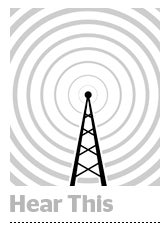 A troupe of traditional broadcasters has a message for media buyers: Your perception of audio streaming audiences is skewed, according to a study by Advertiser Perceptions released Tuesday.
A troupe of traditional broadcasters has a message for media buyers: Your perception of audio streaming audiences is skewed, according to a study by Advertiser Perceptions released Tuesday.
The study, commissioned by terrestrial broadcasters (including Cumulus, Westwood One, iHeartMedia, CBS Radio, Cox Media Group, Hubbard Radio, Radio Advertising Bureau and Radio One) found media buyers overestimated streaming audiences while underestimating AM/FM’s share.
“Radio reaches 93% of Americans every week, which is bigger than television,” said Radha Subramanyam, iHeartMedia’s president of insights, research and data analytics. “But the perception among marketers is that of a declining medium or of a medium that doesn’t have mass reach.”
While the study is positioned to emphasize the advantages of terrestrial radio, streaming radio has its own advantages.
“AM/FM is still the dominant way people listen to audio but as the landscape continues to evolve and become more fragmented, digital audio is the fastest-growing audio platform and something that we continue to watch closely,” said Lydia Foy, VP and managing director of local audio for Horizon Media. “The advantage for the digital audio publishers is their ability to provide real-time tracking and optimization.”
And marketers and agencies are increasingly using data to target audiences based on their behaviors, added Starcom’s local activation lead, Kevin Gallagher.
“Streamed audio offers the ability to target more precisely comparable to the one-to-one model used in digital media vs. the one-to-many model of broadcast,” Gallagher said. “However, when a brand’s primary objective is broach reach, broadcast radio can be used.”
But terrestrial radio still has the reach. Advertiser Perception’s study compared US audio consumption data from Nielsen and Edison Research to media buyers’ perceived listening habits. The study used data from Nielsen’s most recent quarterly “Total Audience Report,” published in 2015’s first quarter, and data from Edison Research’s “Share of Ear” study, also published in Q1.
Advertiser Perceptions conducted an online survey of 327 media decision-makers between May 11 and May 14. Responders estimated that AM/FM radio reaches 64% of Americans, but Nielsen data claims terrestrial radio actually reaches 93% of Americans weekly.
Advertisers also have a warped perception of Spotify and Pandora’s audience share compared to AM/FM, according to the study. Those surveyed estimated the companies’ share to be roughly equal to AM/FM’s. But according to Edison Research and Nielsen data, AM/FM’s share of American audiences is nine times that of Pandora and 17 times that of Spotify.
“One surprise of this study was just how far off us media decision-makers are about Spotify,” said Pierre Bouvard, Cumulus/Westwood One CMO. “We perceive Spotify to be almost as big as Pandora. But according to Edison’s data they’re a third of Pandora in terms of reach.”
He was also surprised at overestimations around Spotify’s size, he added.
“The perception of the media-buying community is that Spotify reaches 20% of Americans, or one out of five Americans,” he said. “The reality of the Edison data is they reach 5%. That means on an average day, 95% of Americans won’t listen to Spotify.”
Spotify declined to comment.
But even if streaming services are a small share of overall listening for Americans, legacy terrestrial broadcasters like NPR and iHeartMedia are moving into streaming.
“We just announced that we’re putting our stations on a platform, called Rdio,” Bouvard said. “We have to look at it this way: We’re content providers. We have to look at every distribution platform and we need to be wherever people are.”
“Streaming is pretty small,” he added. “But it’s certainly a way to get to people.”
For iHeartMedia, Subramanyam said streaming and digital are additive to terrestrial radio.
“Unlike other media, streaming isn’t growing at the cost of radio,” she said. “Traditional radio is growing and it’s dominant. While we embrace streaming and new technology, we also need to understand its true place in the life of American consumers.”
For context, streaming makes up about 5% of overall listening for iHeartMedia.
It’s likely big broadcasters will continue to invest in digital platforms and experiment with streaming, even if share of audience remains low in the short term. But in the meantime, the radio giants are pointing to the data.
“Decision-making has to be based on facts,” said Subramanyam. “It’s very hard to shut out the hype, but that’s what we need to do because ultimately we’re all in the business of driving ROI.”












